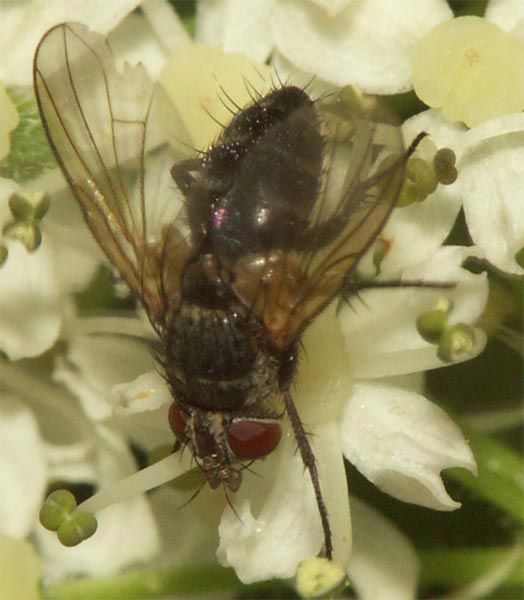Thread subject: Diptera.info :: Anthomyidae ?
Posted by Vadet on 19-08-2004 13:28
#1
This year very common on Heracleum spondylium (the flower give the scale, length about 4 mm)
Boulonnais , Northen France
I think that is an Anthomyidae but can somebody give the correct name,
Best regards
Alain Vadet

Posted by Paul Beuk on 19-08-2004 14:17
#2
Dear Alain,
It is a tachinid fly, not an anthomyid. I leave te identification to someone more knowledgable in that field, though. :p
Posted by cthirion on 19-08-2004 15:48
#3
Curious, vein sinuous as Muscidae, no angular as Tachinidae?
No frequent?
But for that, bristle, and postscutellum hardly visible.
Posted by Paul Beuk on 19-08-2004 15:56
#4
There are a few that have similar wing venation. Looking at illustrations in the key to Middle European species I can name
Eloceria,
Actia and
Siphona. I do not think it is the latter genus, but it might be one of the former two.
Posted by Vadet on 19-08-2004 20:27
#5
Effectively the median vein is not straight,
If it is a tachinid I submit : Zophomia temula
Best regards
Alain Vadet
Posted by cthirion on 19-08-2004 21:30
#6
Thank you, Paul!
Posted by Gerard Pennards on 19-08-2004 21:56
#7
Haai Vadet,
I'm sure the fly is NOT Zophomyia temula, that species is a lustrous black (so very blackish metallic shine), with very yellow wingbase.
Furthermore the legs are covered in rather large spines, and the wing venation is different, look at the angle that the vein makes!.
This one looks a bit like it, but it has some grey coating on the abdomen, and the base of the wing is not that yellow! Also the spines on the legs are smaller. You can look at this picture from Zophomyia that I found on the net, so you can compare!
Greetings

(on website
http://www.mashut...raalgemeen)
Edited by Paul Beuk on 20-06-2006 09:58
Posted by Zeegers on 07-09-2004 17:12
#8
It is indeed a Tachinid, an Actia or possible another member of the tribe Siphonini. These are small flies with converging subapical scutellar bristles and usually a lot of setulae on the wing venation.
Most likely it is an Actia, but I could not tell the species, alas.
Greetings
Theo Zeegers

